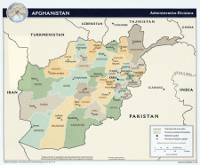For years, The Long War Journal has observed that while media coverage has tended to focus on the Taliban and allied jihadists’ efforts in the Afghan south and west, the groups have devoted significant resources in the north. And not just in the provinces of Kunar and Nuristan. The Taliban and groups such as the Islamic Movement of Uzbekistan and the Turkistan Islamic Party have been active in the northern and northwestern provinces of Badakhshan, Takhar, Baghlan, Kunduz, Samagan, Balkh, Sar-i-Pul, Jawzjan, Faryab, and Badghis. In 2011, the International Security Assistance Force stated that suicide camps were active in both Sar-i-Pul and Samangan, two provinces that have traditionally been free of Taliban activity.
In a recent report by RFE/RL on the growing threat that fighters from Turkmenistan pose in that country as well as in Afghanistan, it is noted that areas in Faryab and Jawzjan remain “no go” zones under Taliban control:
In April 2013, the fiercest fighting in more than a decade broke out in the southern Qaysar district of Afghanistan’s Faryab Province, which borders Turkmenistan. Afghan media reported a nine-day battle between Afghan government forces and some 700 Taliban fighters. Government forces drove them out but in September fighting erupted there again. One of the reported casualties was a Taliban shadow governor from another district of Faryab Province.
RFE/RL correspondents based in Afghanistan tell Azatlyk there are already “no go” zones under Taliban control in Faryab and Jawzjan provinces. These correspondents report an increasing number of Afghanistan’s ethnic Turkmen arming themselves, and some joining the Taliban or foreign fighters, among them Uzbeks allied with the Taliban.
One correspondent reported a “pro-Taliban” group captured a village in Jawzjan Province along the border with Turkmenistan some three months ago. Government forces arrived and chased the group from the village. The group, reportedly mainly ethnic Turkmen led by ethnic Uzbeks, found sanctuary on an island in the Amu-Darya, the river dividing Afghanistan and Turkmenistan, before gradually fading away back into Afghanistan.
The situation in the Afghan north highlights the shortsighted nature of the Afghan “surge,” in which Coalition forces focused on Taliban strongholds in Kandahar and Helmand and to a lesser degree in the east while largely ignoring Taliban activity in the north. The Taliban are beginning to regain control of areas in southern Helmand, so we should not be surprised that areas in the north are considered no-go zones.
Are you a dedicated reader of FDD's Long War Journal? Has our research benefitted you or your team over the years? Support our independent reporting and analysis today by considering a one-time or monthly donation. Thanks for reading! You can make a tax-deductible donation here.









5 Comments
I do sometimes wonder how Turkmen citizens end up in places like Afghanistan, when in Turkmenistan, you have to have an exit visa to go out of the country and very few people obtain that, unless you are a son or a daughter of an diplomat abroad. Is the Turkmen government allowing its citizens to cross the border into Afghanistan, in the hope that they get rid of their islamic terrorist supporters ? If that is the case, I wouldn’t be surprised, because the Turkmen government have always been neutral towards Afghanistan, even allowing a Taliban representative in the country, when the Taliban were ruling Afghanistan, but then again they also had the Northern Alliance representative as well.
‘The situation in the Afghan north highlights the shortsighted nature of the Afghan “surge,” ‘
What was short sighted about the surge?
Was the original surge plan short sighted or was the surge allowed shortsighted?
The fewer resources you are given the more you have to pick and choose.
Was it Sun Tzu who said, “If you fight on all fronts, you fight on none.”
Afghan govt should seal the borders with neighboring countries and clean its soil from
the insurgents once for all.
Having been very close to one of the “no-go zones” myself I can tell you that it has as much to do with the overall lack of interest from NATO-ISAF as anything else. ARCENT North (Kunduz Province/ Mazar-I-Shariff) is commanded by the Germans and all they really want to do is build roads and have bar-b-ques. Sometimes they will conduct a schützenschnur too or obliterate something with an airstrike. The ISAF people up North “Checked out” a long time ago and I don’t imagine them getting back into the game.
J Angel